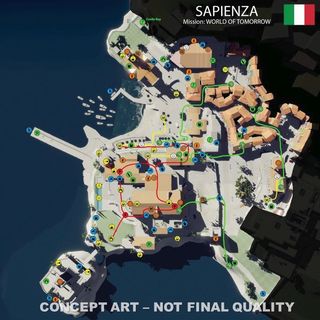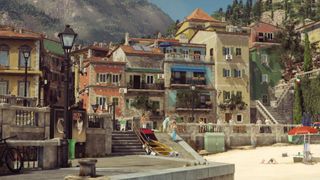The making of Sapienza, Hitman's best level
How this intricate seaside sandbox helped IO to perfect the Hitman formula.

Opportunities can lead to some showpiece moments, but each level must also support more player-driven solutions. “When you take the role of a hitman, it should feel like the world is full of ways to kill people,” Christensen says. “In addition to the more custom setups, we try to have many other possible ways to kill targets. Accidental death should lurk around every corner in the world of assassination.” The challenge is filling the world with ways to kill a target, but not make the act itself trivial to perform. Hence the civilians and guards, who will notice if you do anything suspicious.
NPCs are added early to the level, and refined from there. “We try to make every NPC have a purpose, and only place them where it makes sense,” says Christensen. “The ‘enforcers’ that can see through disguises are often added later, once we start playtesting the mission in depth. Their exact placement, or the direction they look, will be tweaked numerous times to make sure it feels difficult in a fun way.”
IO had never before created a level on this scale. They were attempting to create environments much larger than Blood Money, but with the NPC density of Absolution. “We were building some very large levels, and we had some fundamental questions,” says Elverdam. “How do you navigate? How much traversal is acceptable? How much do people like it?”
Playtesting was invaluable, and helped IO refine many aspects. One of the big changes of this period was to target loops—the route a target will travel and repeat. Initially, Francesca De Santis, Sapienza’s secondary target, would wander around the town. “She went to the church and the cave during her main loop,” says Christensen. “Because of the very long travel times between those locations, we decided to not do this, as it wasn’t fun to wait that long for her to do her loop. Silvio had similar issues, so in order to fix this, both targets’ main loops were shortened.” For both, Opportunities were implemented that let the player trigger events to lure out their targets—furthering the Hitman fantasy of manipulating your quarry.
With both targets confined to the mansion, the town feels quiet and peaceful. Crucially, it still has a purpose. This is one of Sapienza’s most distinctive features—containing the main challenge in the mansion, but filling the town with weapons, secret routes and Opportunities. “Making the town free to explore was a deliberate choice,” says Christensen, “and Sapienza was not filled with busy crowds on purpose, as we wanted a more relaxed ‘siesta’ feel.”

Nevertheless, it was something of a bold departure from previous games. “We were a little bit afraid of the density in small pockets,” says Elverdam, “but I also think that’s one of the things that actually turned out very nicely with Sapienza. It has some space in there and you can actually breathe.”
Each episode is designed to be played many times, in multiple configurations. Where the World of Tomorrow mission keeps things centred around Caruso’s mansion, the Escalation and Elusive Target missions take place all across the town. These alternate missions focus on different targets, often with extra complications for 47 to consider. But while both were part of Hitman’s development plan, neither had an effect on the way Sapienza was designed. “Elusive Targets are not thought of as part of how we build the levels,” says Elverdam, “because the complexity of the sandbox really should dictate that if we build a swiss cheese from the get go, and on an organic level where you can move around, then there should be room for an Elusive Target.”
The biggest gaming news, reviews and hardware deals
Keep up to date with the most important stories and the best deals, as picked by the PC Gamer team.
According to Elverdam, the team responsible for creating Elusive Targets use heatmap data to see where players spend the majority of their time. “If we see that a lot of people don’t necessarily spend a lot of time in the gardens of Paris, then we’ll put in a little garden party and so forth.”
You might assume the same holds true of Contracts—custom missions that players can create and share. Apparently, that’s not the case. “Contracts mode is a little bit more embedded in the early thought process of the level,” says Elverdam, “in the sense that, while Contracts mode does not dictate what a level looks like and how it’s built, there is a pass where we make sure we put in enough patrolling NPCs that they can become interesting targets.” Too many generic NPCs would restrict a Contract creator’s options. “We need to make sure that there are enough small characters and moments and identifiable targets on a level that Contracts mode feels it could take off.”
A more substantial Sapienza remix happened over summer, with the release of Hitman’s bonus episode. It centred the action on the town, turning it into a film set. “It allowed us to use the town square as a trespassing zone, which is something you would almost never do otherwise,” says Elverdam. “The town square and the streets are typically—obviously—for the public, right?” The film set also allowed the team to do something surprising. “I think the idea for a robot invasion in Italy is as far from what people would expect as can come.”

Sapienza has clearly been a success, but not every aspect works as well. 47’s final objective is to destroy Caruso’s virus. “The first time you find the secret cave, and have to find a way to destroy the virus, it works pretty well,” says Christensen. “Playing Hitman can be somewhat of a Groundhog Day experience, and, in that perspective, the virus doesn’t work quite so well ... it quickly becomes a rather annoying thing you have to do, especially considering mission replay value.”
This was something I brought up in my Sapienza review, and clearly something IO has learned from. “I think that has affected how we think about these objectives,” says Elverdam. “I don’t think it’s a bad thing doing them, but we need to be mindful on how, and can we be even more creative in how you accomplish them.” Elverdam stresses that this was their first time building around an objective that wasn’t a target. “I think it’s down to the fact that the way you destroyed the virus maybe doesn’t feel like a ‘hit’. It doesn’t feel like as gratifying or as much of a conclusion ... That’s probably the angle I would attack it from.”
It sounds as if Sapienza’s success has helped build IO’s confidence. “When I look at the willingness to experiment on Colorado and Hokkaido, I don’t think any of us would have been as willing if it hadn’t been for that,” says Elverdam. It’s easy to forget that it’s been ten years since Blood Money. IO wasn’t sure there was still an audience for this style of Hitman design.
“When I look at where IO is today,” says Elverdam, “it’s pretty clear to me that one of the biggest things we’ve achieved is this belief in the Hitman sandbox. Both how to build it, and that there are people who actually like to play it. It might sound straightforward now, but it might not have been as straightforward back then.” Sapienza didn’t just reassure Hitman’s fans. It helped convince IO as well.

Phil has been writing for PC Gamer for nearly a decade, starting out as a freelance writer covering everything from free games to MMOs. He eventually joined full-time as a news writer, before moving to the magazine to review immersive sims, RPGs and Hitman games. Now he leads PC Gamer's UK team, but still sometimes finds the time to write about his ongoing obsessions with Destiny 2, GTA Online and Apex Legends. When he's not levelling up battle passes, he's checking out the latest tactics game or dipping back into Guild Wars 2. He's largely responsible for the whole Tub Geralt thing, but still isn't sorry.
Most Popular


